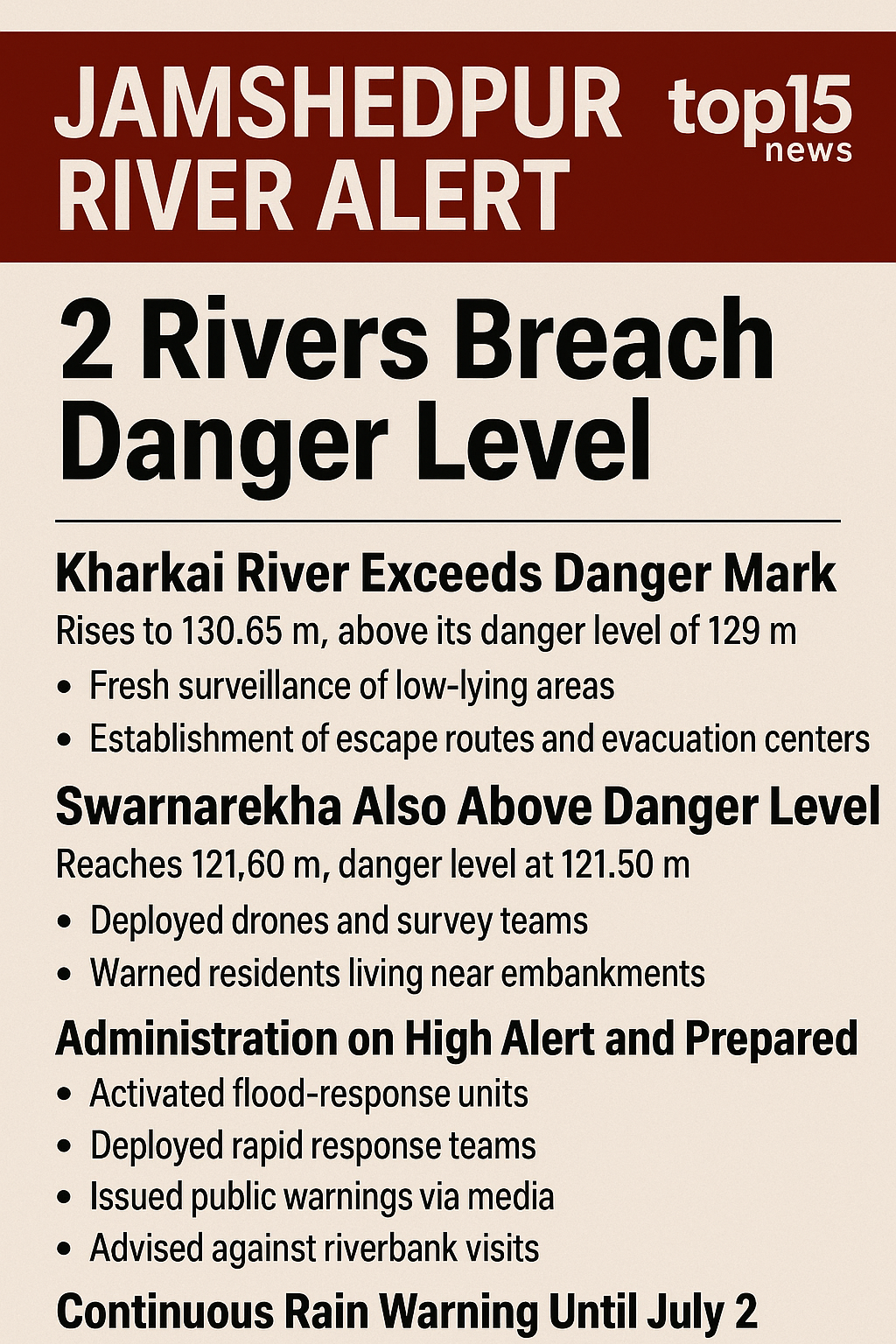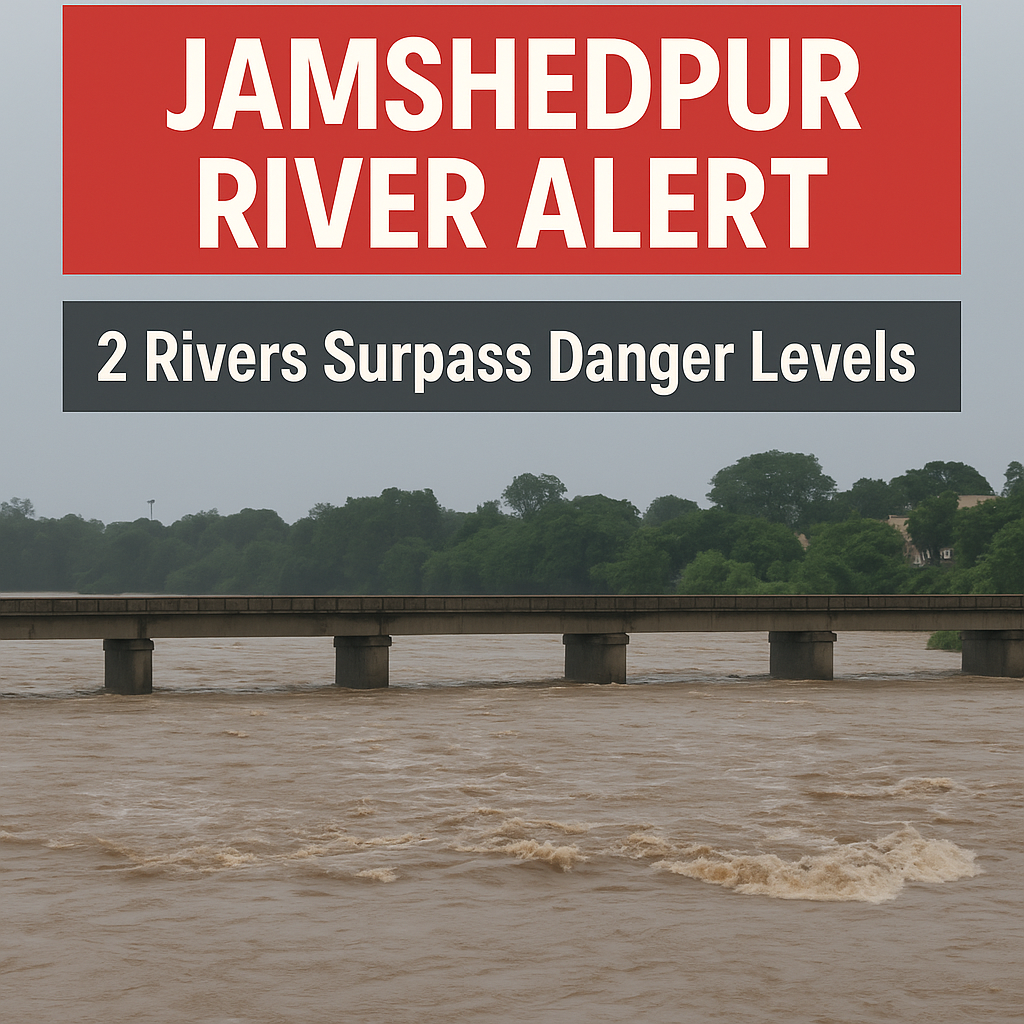The Jamshedpur River Alert has been issued following intense rains across Kolhan last Sunday, causing both Swarnarekha and Kharkai rivers to overflow their danger marks. Rising water levels and active flood monitoring have prompted urgent safety measures and public advisories.
Kharkai River Exceeds Danger Mark
The Jamshedpur River Alert triggered after authorities reported that Kharkai River outran its 129 m danger level, rising to 130.65 m. This 1.65 m breach raises flood risk downstream. Immediate action includes:
- Fresh surveillance of low-lying areas
- Establishment of escape routes and evacuation centers
Swarnarekha Also Above Danger Level
Under the Jamshedpur River Alert, Swarnarekha River has climbed to 121.60 m, slightly above its 121.50 m danger level. Though marginal, this rise can still impact riverside habitats and communities. District administration has:
- Deployed drones and survey teams
- Warned residents living near embankments

Administration on High Alert and Prepared
Following the Jamshedpur River Alert, the district administration and disaster management teams have:
- Activated flood-response units
- Deployed rapid response teams
- Issued public warnings via media
- Advised against riverbank visits
- Prioritized safety for children, elderly, and livestock
These measures aim to prevent loss of life and property.
Continuous Rain Warning Until July 2
The Jamshedpur River Alert comes as Jharkhand Meteorological Department forecasts heavy to very heavy rainfall through July 2, with thunderstorm and lightning threats. Alerts include:
- 30 June: Five districts (Khunti, Ranchi, Ramgarh, Bokaro, Dhanbad, Seraikela-Kharsawan, West Singhbhum)
- 1 July: Six districts to receive very heavy rain (Gumla, Palamu, Garhwa, Latehar, Chatra, Lohardaga), Khunti among others under Yellow Alert
- 2 July: Ten districts—rising flood risk in rivers like Kharkai and Swarnarekha
H2: District-Level Rainfall Forecast Table
| Date | Rainfall Alert | Affected Districts |
| 30 June | Very Heavy Rain | Khunti, Ranchi, Ramgarh, Bokaro, Dhanbad, Seraikela‑Kharsawan, West Singhbhum |
| 1 July | Very Heavy Rain | Gumla, Palamu, Garhwa, Latehar, Chatra, Lohardaga + Yellow Alert in Khunti area |
| 2 July | Heavy to Very Heavy Rain | Ranchi, Gumla, Khunti, Palamu, Garhwa, Latehar, Chatra, Lohardaga, Simdega, W. Singhbhum |

What Residents Should Do Now
With the Jamshedpur River Alert in effect, residents must:
- Avoid riverbanks entirely
- Relocate to higher ground if in flood-prone zones
- Move children, elderly, pets to safety
- Listen to local alerts and updates
- Secure important documents and possessions
These precautions are vital to ensure community safety.
Role of Disaster Management Teams
Disaster management units activated under the Jamshedpur River Alert include:
- District Disaster Response Force (DDRF)
- Local administration teams
- River monitoring squads using sensors and drones
- Mobile medical units on standby
Their duties involve timely evacuation, rescue operations, and emergency aid.
Nature of Flood Risk from River Overflow
The Jamshedpur River Alert reflects a serious scenario:
- Floodwaters can erode embankments
- Risk of submerged farmland and homes
- Potential contamination of water sources
Rapid decision-making and clear communication channels are essential.
How This Alert Affects Your Daily Life
Residents under Jamshedpur River Alert should expect:
- Road closures in low-lying routes
- Disruptions to transport and delivery services
- Temporary suspension of riverside businesses
- Increased river water turbidity and risk of electrical hazards
Plan work, travel, and supplies accordingly.
Forecast and Alert Duration
Meteorology officials confirm that the Jamshedpur River Alert remains valid through July 2, with a review planned post-warnings. Any drop in water level or rainfall intensity will adjust alert status.
also read :- Amarnath Yatra 2025: Traffic Alert With 12 Route Changes
Stay Alert, Act Safe
The Jamshedpur River Alert is not just a warning—it’s a call for community action. Heavy rains and overflowing rivers demand caution, cooperation with authorities, and readiness to evacuate. Safeguarding lives and livelihoods is top priority.


